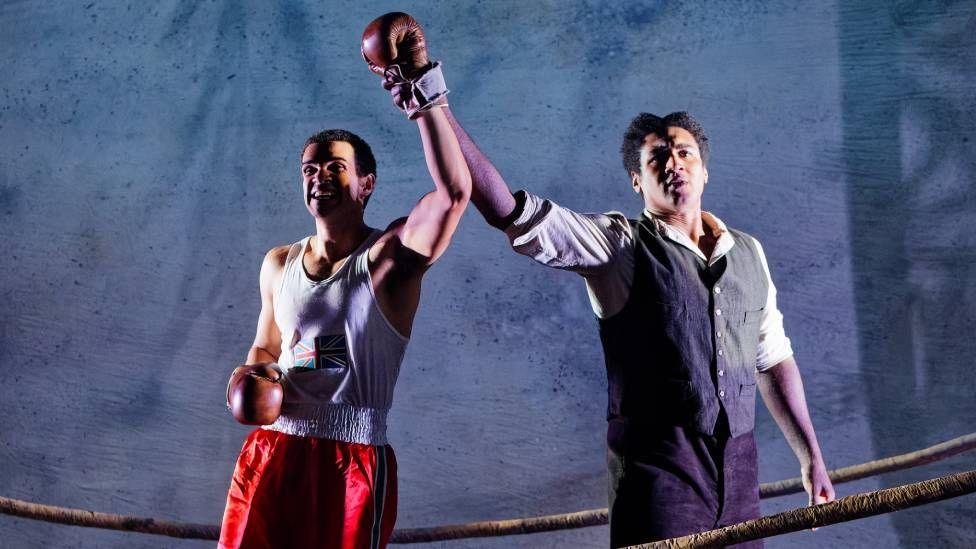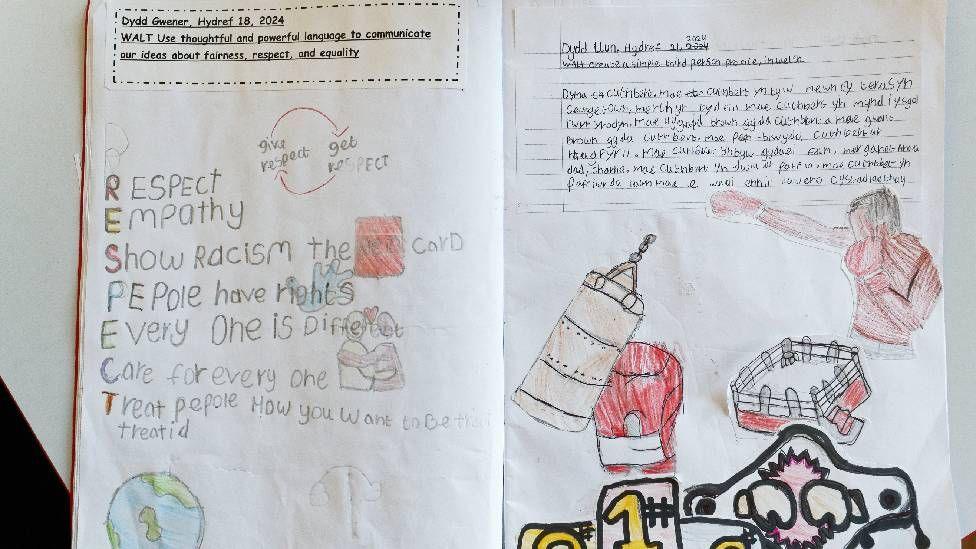Apology demanded for black boxer denied title shot

Cuthbert Taylor represented Great Britain at the Olympics but was denied the right to fight for the British title because he was black
- Published
Hundreds of schoolchildren have written to sporting representatives and the UK government calling for an apology for a black man who was denied the right to fight for a title because of his skin colour.
Cuthbert Taylor, born in Merthyr Tydfil in 1909, represented Great Britain at the Olympics, could not fight for the British title because both his parents were not white.
His story and that of boxing’s colour bar - which ran from 1911 to 1948 - is being brought to life in a play called The Fight.
Their letters addressed the British Boxing Board of Control (BBBoC) – which implemented the colour bar – as well as Culture Secretary Lisa Nandy.
Boxing's shameful past retold in play
- Published14 September 2024
Boxer's family want historical colour bar apology
- Published30 October 2021
Statue of Wales' rugby pioneers unveiled
- Published19 July 2023
One letter, written by students at Cwmnedd Primary School in Neath Port Talbot, described the colour bar as "horrendous, horrific and disgraceful", saying it was "not right then, and it is not right now".
Cuthbert was born to a Liverpool-born man of Jamaican heritage and Welsh mother, competing for Great Britain in the 1928 Amsterdam Olympics where he reached the quarter final.
He was the first black boxer to represent Great Britain, and the country's third ever black Olympian, external.
In a 20-year professional career, he won 151 bouts, drew 22 and lost 69.
But he was denied the right to fight for the British title because, according to BBBoC’s rules, fighters had to have “two white parents”.
Having seen The Fight - which recently completed runs at Swansea’s Dylan Thomas Theatre and Theatr Brycheiniog in Brecon, Powys – students from a number of schools in south Wales were inspired to write the letters calling for an apology.
One letter from Katie H and Morgan G, students at Cwmnedd Primary School in Neath Port Talbot, said it was “unfair” that boxers without white, British parents were not allowed to fight for the British title.
“The colour bar was horrendous, horrific and disgraceful. It was not right then, and it is not right now. The awful act can be reconciled by apologising to the boxers,” the letter said.
“It was entirely the children’s idea to pen letters to the British Boxing Board of Control,” said Aisling Brady Saunders, deputy headteacher at St Joseph’s Junior School in Port Talbot, another school taking part.
“They feel very strongly that Cuthbert Taylor, his surviving family and all boxers affected by the colour bar rule should have an apology and be recognised for their sporting achievements.”
The BBBoc has said boxing was one of the “most diverse and inclusive sports” in the UK and acknowledged that the colour bar was wrong, but did not apologise.
The UK government's Department for Digital, Culture, Media and Sport, external (DCMS) said an apology was firstly a matter for the BBBoC and that it “does not wish to unduly influence their response”, adding that it will respond to the letters “in due course”.
It added “by today’s standards, the prohibition that was in place in the early part of the last century was plainly racist”.

Children from numerous schools have written to the BBBoC and the government calling for an apology
Nick Taylor, Cuthbert Taylor’s grandson, described the letter campaign as “absolutely amazing”.
“It’s really nice to know that people are actually paying attention to something that’s over 100 years old,” he told BBC Radio Wales Breakfast.
Geinor Styles, who wrote The Fight and is from Merthyr Tydfil, said she knew Cuthbert’s story would resonate with young people.
“I just thought it would make a fantastic story to tell young people about the trials people faced at that time, and what they had to overcome to succeed,” she said.
She described the response to the play, including the letter writing campaign, as “overwhelming”, saying the students had “taken the initiative” because they felt strongly about the issue.
“You always hope that when you create theatre shows that it has an impact, and we always say that theatre and arts can change lives. Well this is absolutely testament to that,” she said.
Of the colour bar, the BBBoC said: “Of course, the board acknowledges that the implementation of the ‘colour bar’ was discriminatory, and the board accepts this was wrong. Indeed, the British Boxing Board of Control condemn in the strongest terms the colour bar that existed in professional boxing between 1911 and 1948.”